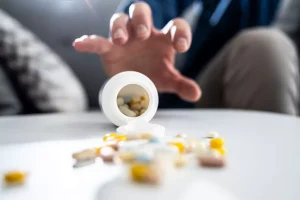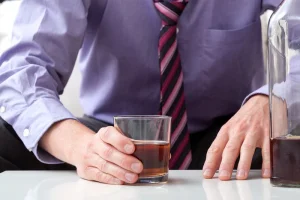
AWS is a cause of severe discomfort to patients, symptoms are disabling and patients who experienced withdrawal, often are afraid to stop drinking for fear of developing withdrawal symptoms again. The main goal of the treatment is to minimize the severity of symptoms in order to prevent the more severe manifestations such as seizure, delirium and death and to improve the patient’s quality of life [6, 44]. Moreover an effective treatment of AWS should be followed by efforts in increasing patient motivation to maintain long-term alcohol abstinence and facilitate the entry into a relapse prevention program [6, 44]. In the outpatient setting, mild alcohol withdrawal syndrome can be treated using a tapering regimen of either benzodiazepines or gabapentin administered with the assistance of a support person.
Complications
Moderately severe AWS causes moderate anxiety, sweating, insomnia, and mild tremor. Those with severe AWS experience severe anxiety and moderate to severe tremor, but they do not have confusion, hallucinations, or seizures. When not properly treated, AWS can progress https://ecosoberhouse.com/ to delirium tremens (Table 38–10). According to the National Institute on Alcohol Abuse and Alcoholism (NIAAA), alcohol is the most commonly used substance in the United States, with over 75% of individuals aged 12 and older reporting lifetime consumption.

Who is at risk of alcohol withdrawal delirium
The doctor needs to know your problem and if you have had it before. They will treat and manage your symptoms to make sure they don’t lead alcohol withdrawal syndrome symptoms to other health problems. If you go through withdrawal more than once and don’t receive treatment, your symptoms can get worse each time.
Assessing Severity
Having a doctor monitor your symptoms can help you reduce your alcohol intake as safely as possible and lower the risk of more serious complications. Toxicology screening is typically done with a blood or urine sample, and can also indicate if any other substances are in your body. If you’re receiving inpatient treatment, your doctor may perform toxicology screens more than once to monitor your alcohol levels. Contact your doctor right away if you’re concerned about the symptoms you’re experiencing during alcohol withdrawal. It’s rare for people going through alcohol withdrawal to experience hallucinations more than 48 hours after their last drink.

In some situations, a doctor or psychiatrist might prescribe medication to help with PAWS symptoms. Your medication options depend on the substance you used, your symptoms, and your medical history. Taking care of your basic needs is a good way to avoid worsening your mental and physical symptoms. Your triggers could include stress, sleeplessness, or even certain foods. Although the symptoms of PAWS can be challenging, it’s possible to manage your symptoms in a healthy way.
6 Other Drugs

The use of a clinician-administered scale (CIWA-Ar or Alcohol Withdrawal Scale) is important to diagnose AWS and start adequate treatment. BZDs represent the gold standard treatment as a result both for their high rate of efficacy and being the only medications with proven ability to prevent the complicated forms of AWS (seizures, DTs). The alcohol withdrawal timeline varies, but the worst of the symptoms typically wear off after 72 hours. People who are daily or heavy drinkers may need medical support to quit. Stopping drinking abruptly can lead to seizures and can even be fatal. If you begin experiencing severe symptoms of AWS, it’s important to seek immediate medical attention.
- However, if a person already has alcohol use disorder, they can help prevent some of the withdrawal symptoms by speaking to a doctor about safe withdrawal.
- Proposed regiments include fixed dosing with as-needed doses available.
- Approximately one-half of patients with alcohol use disorder who abruptly stop or reduce their alcohol use will develop signs or symptoms of alcohol withdrawal syndrome.
- By Sarah Bence, OTR/LBence is an occupational therapist with a range of work experience in mental healthcare settings.
- Usually, 1st degree AWS symptoms (tremors, diaphoresis, nausea/vomiting, hypertension, tachycardia, hyperthermia, tachypnea) begin 6–12 hours after the last alcohol consumption, lasting until the next drink [26].
- Among them, different agents (i.e., long-acting or short-acting) and different regimens (front-loading, fixed dose or symptom-triggered) may be chosen on the basis of patient characteristics.
- A “fixed-dose”, rather than a “loading dose” or a “symptoms-triggered” regimen can be adopted for the management of AWS.
- In extreme cases, the brain can have problems regulating breathing and circulation.


Leave a Reply